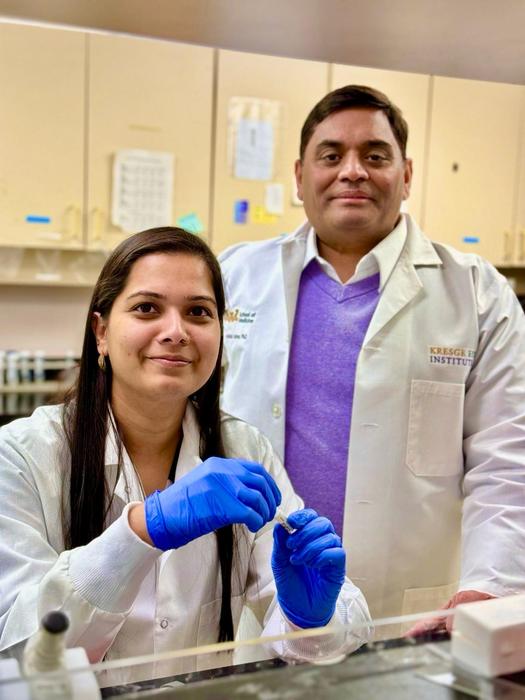Pulmonary T2* MRI: New Fetal Lung Assessment Tool?
In a groundbreaking advancement poised to redefine prenatal diagnostics, researchers are exploring the quantification of pulmonary T2 as a novel method to assess fetal lung status in cases of congenital diaphragmatic hernia (CDH). This innovative approach holds the potential to become an alternative or complementary technology to current ultrasound techniques, offering unprecedented insights into the […]


In a groundbreaking advancement poised to redefine prenatal diagnostics, researchers are exploring the quantification of pulmonary T2 as a novel method to assess fetal lung status in cases of congenital diaphragmatic hernia (CDH). This innovative approach holds the potential to become an alternative or complementary technology to current ultrasound techniques, offering unprecedented insights into the delicate pulmonary environment before birth. Given the complex challenges associated with monitoring and managing fetal lung development in CDH, the advent of T2 magnetic resonance imaging (MRI) quantification presents a powerful leap toward more accurate and predictive prenatal care.
Congenital diaphragmatic hernia is a severe developmental anomaly characterized by the improper formation of the diaphragm, allowing abdominal organs to herniate into the thoracic cavity. This displacement severely impairs lung development and function, often leading to pulmonary hypoplasia and chronic respiratory distress after birth. Despite advances in neonatal care, CDH remains a leading cause of neonatal morbidity and mortality worldwide. The precise evaluation of fetal lung maturity and vascularization is crucial for tailoring perinatal interventions and improving clinical outcomes. However, current prenatal imaging modalities, primarily ultrasound, have inherent limitations in sensitivity and quantitative assessment.
Ultrasound, the clinical standard for fetal lung evaluation, suffers from operator dependency and limited resolution, especially in complex cases complicated by CDH. It provides mostly qualitative or semi-quantitative data, insufficient for confidently predicting respiratory function postnatally. In contrast, magnetic resonance imaging (MRI) offers superior soft tissue contrast and higher spatial resolution, enabling detailed visualization of lung morphology. Within MRI modalities, T2 relaxation time—reflecting tissue oxygenation and microstructural properties—has emerged as a promising biomarker. The T2 value corresponds to the decay of transverse magnetization affected by local magnetic field inhomogeneities, which are in turn influenced by levels of blood oxygenation and iron presence.
.adsslot_1hWIiBjxwl{ width:728px !important; height:90px !important; }
@media (max-width:1199px) { .adsslot_1hWIiBjxwl{ width:468px !important; height:60px !important; } }
@media (max-width:767px) { .adsslot_1hWIiBjxwl{ width:320px !important; height:50px !important; } }
ADVERTISEMENT
The recent study conducted by Forth and Tingay delves into the application of pulmonary T2 quantification in fetuses diagnosed with CDH, seeking to establish correlations between T2 measurements and lung health. Using advanced MRI sequences optimized for fetal imaging, the researchers measured T2 values in the lungs during the critical developmental window. The methodology involves capturing multi-echo gradient echo images to calculate T2 decay curves with precision. This quantitative technique allows assessing not only lung volume but also functional parameters such as oxygenation status, which are vital for understanding pulmonary hypoplasia severity.
One of the fundamental strengths of pulmonary T2 quantification lies in its non-invasive nature and ability to deliver objective data beyond conventional imaging. Unlike Doppler ultrasound, which assesses blood flow indirectly, T2 MRI offers direct insights into tissue oxygenation by exploiting magnetic susceptibility effects. This represents a paradigm shift in prenatal evaluation, as it facilitates early detection of compromised lung function before structural deficits become overt. Early identification can guide critical clinical decisions, including the timing of delivery, administration of steroids to enhance lung maturation, or planning of fetal surgical interventions.
Technically, the integration of fetal motion compensation algorithms and rapid acquisition sequences has overcome previous barriers to implementing T2 imaging in utero. Fetal MRI is inherently challenging due to constant movement and limited acquisition windows. However, innovations such as prospective motion correction, real-time image registration, and single-shot echo planar imaging have enabled reliable collection of T2 data. These advancements ensure that pulmonary T2* quantification is feasible, reproducible, and clinically applicable for a broad spectrum of cases, including those with severe diaphragmatic defects.
Furthermore, the study’s data reveal significant differences in T2 values between CDH-affected lungs and healthy controls, highlighting the potential of T2 to serve as a biomarker distinguishing varying degrees of pulmonary hypoplasia. Lower T2* values are indicative of reduced oxygenation and altered vascular density, correlating with worse respiratory outcomes postnatally. This quantitative imaging biomarker could thus inform risk stratification models, enabling clinicians to identify fetuses at highest risk who might benefit most from intensive monitoring and specialized therapies after birth.
From a pathophysiological perspective, T2 quantification offers an unprecedented window into the microenvironment of the developing lung. Changes in T2 reflect alterations in alveolar-capillary network formation, hemoglobin oxygen saturation, and tissue iron metabolism, all crucial for healthy pulmonary maturation. Understanding these parameters in vivo helps elucidate the mechanisms underlying CDH-related lung impairment, potentially revealing novel therapeutic targets. For example, if T2* mapping identifies regions of impaired oxygen delivery or vascular growth, targeted interventions to promote angiogenesis might be explored safely in utero.
The translation of T2 MRI quantification into routine clinical workflows could transform prenatal counseling as well. Currently, prognostic discussions often rely on empirical measures and qualitative findings. Quantitative T2 measurements provide objective data to better predict neonatal respiratory capacity, thereby reducing uncertainty for families and care teams. Enhanced prognostication would also optimize resource allocation, enabling neonatal intensive care units to prepare appropriately and anticipate complications with greater confidence.
Beyond CDH, the implications of pulmonary T2 imaging extend to a spectrum of fetal lung disorders, including pulmonary hypoplasia due to oligohydramnios, cystic malformations, or congenital infections. The ability to noninvasively measure tissue oxygenation and structure in the developing lung introduces a new dimension to fetal medicine. Future research may explore longitudinal T2 monitoring to track lung maturation trajectories over gestation, potentially assessing response to in utero therapies such as tracheal occlusion or pharmacological agents.
While promising, implementing pulmonary T2 quantification in clinical practice requires overcoming several hurdles. Standardization of MRI protocols across centers, validation of normative T2 values at different gestational ages, and integration with existing diagnostic algorithms are necessary. Large multicenter studies will be essential to confirm the robustness of T2* as a predictive biomarker and to define thresholds that correlate with functional outcomes. Moreover, cost-effectiveness analyses must be conducted to justify widespread adoption in high-risk pregnancies.
Ethical considerations also arise, as enhanced imaging capability might lead to more complex decision-making regarding fetal interventions and delivery planning. Multidisciplinary collaborations among radiologists, neonatologists, obstetricians, and ethicists will be crucial to ensure that cutting-edge fetal imaging techniques are deployed responsibly and equitably, maximizing benefits while minimizing potential harm.
In conclusion, the quantification of pulmonary T2 presents a revolutionary approach to fetal lung assessment in congenital diaphragmatic hernia, moving beyond the constraints of ultrasound to embrace a quantitative, functional imaging paradigm. By accurately characterizing lung oxygenation and microstructure in utero, this technique promises to improve diagnosis, guide therapeutic strategies, and ultimately enhance neonatal outcomes. As fetal MRI technology continues to evolve, pulmonary T2 quantification stands at the forefront of personalized prenatal medicine, illuminating the path toward safer and more effective management of complex congenital lung diseases.
Subject of Research: Pulmonary T2* quantification as a diagnostic tool for fetal lung status assessment in congenital diaphragmatic hernia.
Article Title: Pulmonary T2* quantification of fetal lung status in congenital diaphragmatic hernia: future alternative to ultrasound?
Article References:
Forth, A., Tingay, D.G. Pulmonary T2 quantification of fetal lung status in congenital diaphragmatic hernia: future alternative to ultrasound?. Pediatr Res* (2025). https://doi.org/10.1038/s41390-025-04241-4
Image Credits: AI Generated
Tags: alternative imaging methods for CDHcongenital diaphragmatic hernia diagnosisfetal lung assessment techniquesfetal lung development monitoringimproving clinical outcomes in CDHneonatal morbidity and mortalityperinatal intervention strategiesprenatal care innovationsprenatal diagnostics advancementsPulmonary T2* MRIquantification of pulmonary T2ultrasound limitations in fetal evaluation
What's Your Reaction?


































